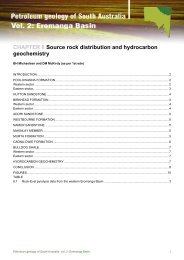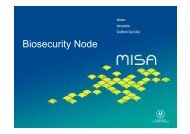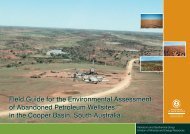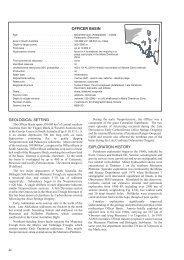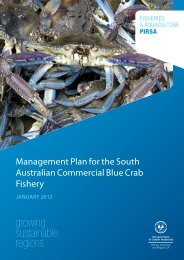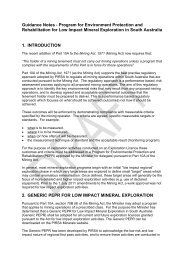Petroleum geology <strong>of</strong> South Australia. Vol. 4: Cooper Basin.Merrimelia 2. A non-commercial gas flow was made atMerrimelia 4. A perceived lack <strong>of</strong> porosity <strong>and</strong> effectivepermeability was considered to count against Merrimeliacontaining commercial hydrocarbons. More significantly,the discovery by Delhi–Santos <strong>of</strong> natural gas at Moomba 1,drilled from March 1966 further vindicated the department<strong>and</strong> the believers in the industry. Several <strong>exploration</strong> wellsat Moomba, 30 km south <strong>of</strong> Gidgealpa, proved the existence<strong>of</strong> large widespread gas reserves <strong>and</strong> paved the way for theCooper Basin to be developed.SECURING DEVELOPMENTAfter the Innamincka pegging ceremony in 1959,Playford apparently learned from Delhi’s Deputy Chairmanthat the company was more interested in controllingpipelines than in the oil <strong>and</strong> gas itself (Sprigg, 1993). ThePremier then organised a study <strong>of</strong> the relevant Americanlegislation to ensure State ownership <strong>of</strong> any pipeline<strong>development</strong>. In the March 1965 election campaign, hepromised a new power station capable <strong>of</strong> utilising naturalgas would be constructed at Torrens Isl<strong>and</strong> (Adelaide) <strong>and</strong>that there would be a pipelines authority to control the gassupplies. Despite the Playford Government’s defeat at thiselection, the proposals were proceeded with by thein-coming Australian Labor Party (ALP) Government. TheALP Premier, F. Walsh, the new Minister <strong>of</strong> Mines, S.Bevan, T.A. Barnes (Director <strong>of</strong> Mines, 1956–70) <strong>and</strong> L.W.Parkin (then Deputy Director <strong>of</strong> Mines) travelled to the USA<strong>and</strong> Europe for almost three months in 1966 to examinepipeline <strong>development</strong>s. While overseas the news <strong>of</strong> theMoomba discovery reached them <strong>and</strong> made it clear thatSouth Australia had an energy resource that could bedeveloped. The probability <strong>of</strong> a pipeline being constructedto carry the gas reserves to Adelaide was confirmed.The State Government wanted to build, own <strong>and</strong> operatethe pipeline to carry the gas to Adelaide but the expense wasbeyond South Australia’s financial capacity. The proposalrequired a combination <strong>of</strong> Federal <strong>and</strong> State Government<strong>and</strong> private sector (the gas producers <strong>and</strong> consumers) capital.This was in line with the model studied overseas. A Stateinstrumentality could also secure lower interest rates <strong>and</strong> alonger loan repayment period. The Natural Gas PipelinesAuthority <strong>of</strong> South Australia (PASA) was established by theNatural Gas Pipelines Authority Act 1967. Based on thestructure <strong>of</strong> the Alberta Gas Pipelines Authority, the initialPASA Board comprised representatives from the StateGovernment (two) <strong>and</strong> one each from the Electricity Trust <strong>of</strong>South Australia (ETSA: established in 1946, now ETSACorporation <strong>and</strong> Optima Energy), the South Australian GasCo. (Sagasco: established in 1861, now Boral Energy),Santos <strong>and</strong> Delhi. PASA was given the power to construct<strong>and</strong> operate pipelines for carrying natural gas <strong>and</strong> relatedsubstances within South Australia.The tide turned in securing the pipeline <strong>development</strong>when ETSA, Sagasco, Adelaide Cement <strong>and</strong> SouthAustralian Portl<strong>and</strong> Cement all agreed to purchase naturalgas (Donovan <strong>and</strong> Kirkman, 1986; Gibbs, 1988; Young,1990). ETSA in particular had to be convinced that therewas a place for gas: it was reluctant to build a power stationfired by gas when the known reserves were minimal while astation had a 30-year write-<strong>of</strong>f period. The decision toconvert its planned coal-burning station at Torrens Isl<strong>and</strong> toThe Moomba Natural Gas Processing Plant under construction inSeptember 1969. (Photo N019880)gas was vital: the Adelaide market was large enough tojustify the cost <strong>of</strong> pipeline construction. But for CooperBasin gas to compete, the price had to be at or below theprice <strong>of</strong> fuel oil or coal from New South Wales, the mainalternatives available. To justify significant use <strong>of</strong> gas, theprice also had to be below the cost <strong>of</strong> Leigh Creek coal.ETSA remained a stumbling block in the negotiations overgas supplies <strong>and</strong> prices: because it could use either oil or gasfor generating electricity it had a valid commercial reasonnot to buy gas instead <strong>of</strong> oil unless the price was morefavourable. ETSA made a few minor concessions but theproducer companies were forced to agree to its terms, whichincluded a 20-year contract for specified volumes <strong>of</strong> gas atan average price <strong>of</strong> 26 cents per 1.055 gigajoule (GJ)delivered in Adelaide, without regard to the effects <strong>of</strong>inflation (Young, 1990).The 56 cm outside diameter pipeline over 750 km fromMoomba to Adelaide was completed in July 1969 <strong>and</strong> wasopened <strong>of</strong>ficially at Elizabeth in November. For many yearsSagasco had distributed a town gas blended from coal gas,LPG <strong>and</strong> other hydrocarbons to Adelaide <strong>and</strong> some regionalcentres. Converting to natural gas, initiated in 1969, wascompleted in the metropolitan area in early 1971. Adelaidewas the second city in Australia (after Brisbane) to beprovided with clean, <strong>and</strong> cheap, natural gas through apipeline (Donovan <strong>and</strong> Kirkman, 1986).Other legislative changes also reflected the importance<strong>of</strong> the <strong>petroleum</strong> search. Amendments to the Petroleum Actin 1958 increased the terms <strong>of</strong> <strong>exploration</strong> <strong>and</strong> prospectinglicences to five years with the right <strong>of</strong> renewal. Then in 1967the Act <strong>and</strong> its regulations underwent a major revision <strong>and</strong>redefined many <strong>of</strong> the terms to account for recent<strong>development</strong>s <strong>and</strong> <strong>petroleum</strong> research. These amendmentsstrengthened the power <strong>of</strong> the Minister to enforce<strong>exploration</strong> <strong>and</strong> production. The 1967 Act renamed the OELas a <strong>petroleum</strong> <strong>exploration</strong> licence (PEL), the oil prospectinglicence was repealed <strong>and</strong> the oil mining licence was replacedby a <strong>petroleum</strong> production licence (PPL). The area for aPEL was not to exceed 25 900 km 2 <strong>and</strong> a five-year<strong>exploration</strong> program had to be maintained. Upon eachrenewal <strong>of</strong> a PEL at least a quarter <strong>of</strong> the area grantedoriginally was to be excised from the lease. The PPL, for upto 259 km 2 , was granted for 21 years with the right <strong>of</strong>renewal: it imposed a royalty <strong>of</strong> 10% per annum <strong>of</strong> the value<strong>of</strong> the <strong>petroleum</strong> at the wellhead. The Act provided for the24
Petroleum geology <strong>of</strong> South Australia. Vol. 4: Cooper Basin.The Moomba Natural Gas Processing Plant in November 1969.(Photo 43830)conservation <strong>of</strong> resources, the prevention <strong>of</strong> operationscontaminating water or <strong>petroleum</strong>-bearing formations,‘proper’ drilling operations <strong>and</strong> the disposal <strong>of</strong> associatedwaste products. Pipeline construction <strong>and</strong> operationrequired licences. A Petroleum Advisory Committee wasestablished to consider appeals <strong>and</strong> objections to theMinister’s decisions under the Act.Delhi–Santos’s OELs 20 <strong>and</strong> 21 were reissued in March1969 but were not converted to PELs 5 <strong>and</strong> 6 (an area <strong>of</strong>497 450 km 2 ) until after 30 June 1969 (Fig. 2.5). At that timethe licensees reduced their area by surrendering the regionseaward <strong>of</strong> Eyre Peninsula. PELs 5 <strong>and</strong> 6 were issued for aguaranteed 20 years without area relinquishments <strong>and</strong> withnominal <strong>exploration</strong> requirements <strong>and</strong> the right <strong>of</strong> renewalfor a further 20 years, an option which was revised at thestart <strong>of</strong> 1979.The Natural Gas Pipelines Authority Act <strong>and</strong> PetroleumAct extended the Government’s powers <strong>and</strong> authorised it tocontrol <strong>and</strong> regulate the oil <strong>and</strong> gas <strong>exploration</strong>,<strong>development</strong> <strong>and</strong> production processes. The oil <strong>and</strong> gasbelow the surface <strong>and</strong> the production <strong>and</strong> transport facilitiesabove were increasingly under Crown control.PROVING UP THE COOPER BASINGas <strong>and</strong> oil <strong>exploration</strong>The perception <strong>of</strong> South Australia being deficient inenergy resources was slowly overturned. Natural gas in thePermian reservoirs at Gidgealpa <strong>and</strong> Moomba showed thatthe Cooper Basin was a gas province <strong>and</strong> the opening <strong>of</strong> theMoomba–Adelaide pipeline demonstrated the commercialviability <strong>of</strong> the region. The oil potential remained atantalising possibility however.The boom that permeated the Australian mining scene inthe 1960s introduced several <strong>exploration</strong> companies to theCooper Basin as partners with Delhi–Santos in specific areas(farmout blocks). Farmin arrangements injected badlyneeded capital to the <strong>petroleum</strong> search in 1969 <strong>and</strong> 1970 <strong>and</strong>,partly as a result, sufficient discoveries were made tocompete with Esso–BHP’s Gippsl<strong>and</strong> Basin gas for supplyto Sydney. Participants in the Cooper Basin includedVamgas, Bridge Oil, Alliance Petroleum Australia,Crusader Oil, Pexa Oil <strong>and</strong> Western Mining.In 1970 more than 5000 km <strong>of</strong> seismic data wererecorded <strong>and</strong> 20 <strong>exploration</strong> wells drilled in the CooperBasin region. The Della gas field was discovered in July1970 by Pursuit–Delhi–Santos–Vamgas with their first wellon the Nappacoongee–Murteree Ridge (Pyecr<strong>of</strong>t, 1973). In1969 Alliance had earnt a 50% interest in theMerrimelia–Innamincka Block through an agreement withDelhi–Santos–Vamgas: Alliance then drilled Merrimelia 5which was completed as a gas producer in 1970 (Bowering<strong>and</strong> Harrison, 1986). Other Cooper Basin gas discoveries in1970 were Packsaddle, Tirrawarra, Mudrangie <strong>and</strong>Strzelecki. Bridge Oil’s announcement in July 1970 <strong>of</strong> a gasflow from the Patchawarra Formation <strong>and</strong> light crude oil inthe Tirrawarra S<strong>and</strong>stone at Tirrawarra 1 indicated that thelong search for oil might at last pay dividends. Although thisfirst oil to flow to the surface in the basin indicated that oil incommercial quantities existed in South Australia, the extent<strong>of</strong> the reservoir <strong>and</strong> how it might best be brought to marketremained to be established.Tirrawarra brought a liquids pipeline to the coast intoserious contention but flooding at Moomba during 1971slowed an evaluation <strong>of</strong> the area. The discovery set thescene for more <strong>exploration</strong> in the basin with gas being foundat Big Lake, Coonatie, Dullingari, Burke, Brumby <strong>and</strong>Kanowana in 1971 <strong>and</strong> 1972, as well as oil <strong>and</strong> gas at FlyLake <strong>and</strong> Moorari. In addition, the gas reserves were revised<strong>and</strong> upgraded in several instances such as Toolachee, Della<strong>and</strong> Tirrawarra (Hollingsworth, 1989). Between July 1970<strong>and</strong> April 1972 a further six wells were drilled on structure atA small-scale Department <strong>of</strong> Mines seismic refraction survey,1973. (Photo T023007)25










